The Photographer Capturing the South From Waffle House Booths
Micah Cash’s journey to 125 diners was fueled by burnt coffee, scrambled eggs, and Southern hospitality.
“Waffle House does not care how much you are worth, what you look like, where you are from, what your political beliefs are, or where you’ve been,” photographer Micah Cash writes in the opening to his 2019 book Waffle House Vistas, “so long as you respect the unwritten rules of Waffle House: Be kind, be respectful, and don’t overstay when others are waiting for a table.”
He would know: Since 2018, Cash has sat in the booths of about 125 Waffle Houses and took photos of the world outside of their windows. For Cash, the ubiquitous Southern diner chain offered a perch from which to stare unflinchingly at his native South, from its old oak trees to its sprawling apartment complexes. And from the diner booths where he sat, surrounded by the smell of fried bacon and burnt coffee, he experienced what he believes the South, with some work, can become: a place where the food is good and everybody is welcome.

“Like it or not, the Waffle House is your neighborhood diner, replicated thousands of times over,” Cash writes. The chain, founded in 1955 in Avondale Estates, Georgia, consists of about 1,500 restaurants in 25 states stretching from Pennsylvania to Arizona. No matter where they’re located, the franchises serve the same menu of Southern diner classics such as steak and eggs, Texas melts, and their namesake waffles. Their hash browns are so storied that the menu comes with a dictionary of hash brown terms: “scattered” means spread across the grill, “covered” means topped with American cheese, and “country” hash browns come drenched in sausage gravy. They sling breakfast in communities of myriad backgrounds, from wealthy to poor, urban to rural, predominantly Black to predominantly white to predominantly Latinx.
Across these differences, their food and service are so dependable that the Federal Emergency Management Agency (FEMA) consults an informal “Waffle House Index” to determine the severity of a storm’s impact on a community, where “Red” corresponds to a closed Waffle House, “Yellow” corresponds to a limited menu, and “Green” indicates an open Waffle House.
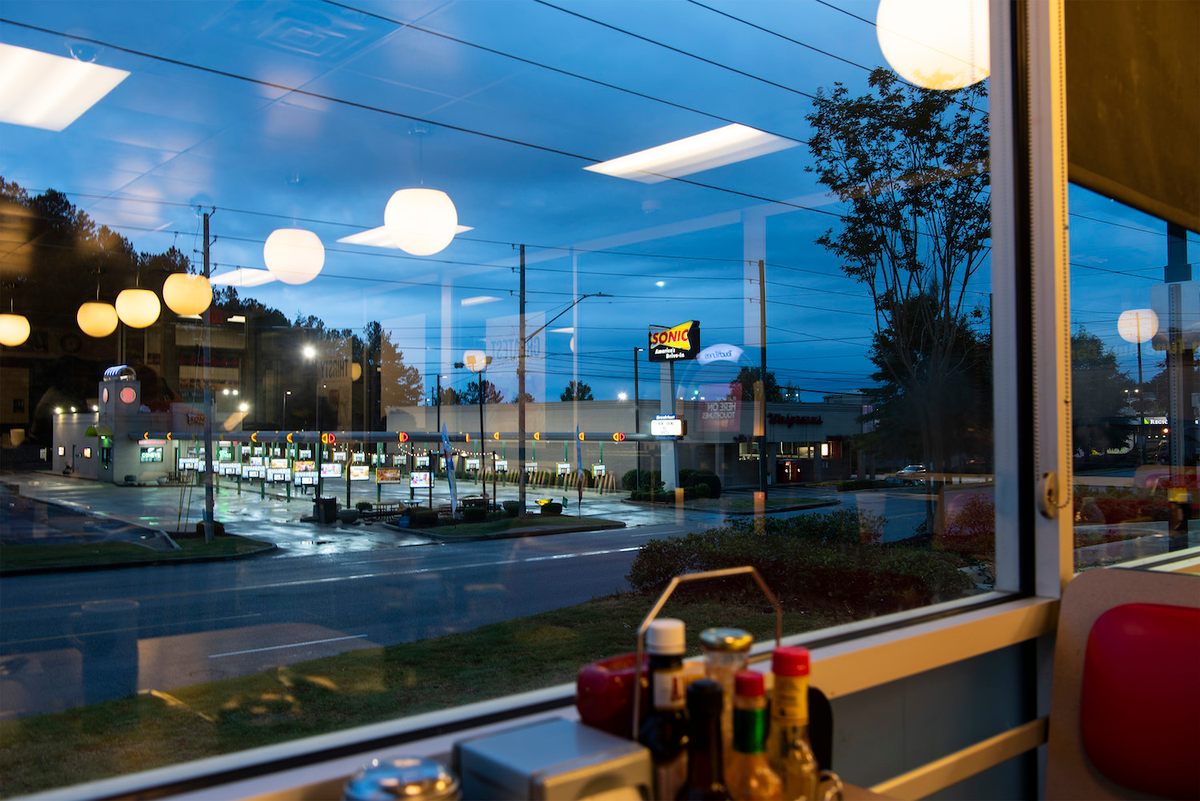
Cash, a conceptual artist interested in geography and social history, came upon the idea for this project while eating at a Waffle House in Myrtle Beach, South Carolina, in 2018. Looking out the window, he noticed a Dollar General store and a payday loan lender, and wondered how often Waffle Houses are built around such businesses, and what that might say about the forces that put them there.
He traveled to Waffle Houses across the Southeast, eating at one to six Waffle Houses in a day and spending 10 to 25 minutes on each visit. From their bar stools and booths, he captured clear-eyed landscapes of houses, strip malls, highways, and scraggly fields. In the morning, he would order two eggs, crispy bacon, toast, and hash browns (scattered). “If I’m feeling crazy, I’ll ask for cheese on them,” he adds. In the afternoon or evening, he would limit himself to coffee and a slice of toast. Then, on a belly full of Southern hospitality, he would pull out his camera.
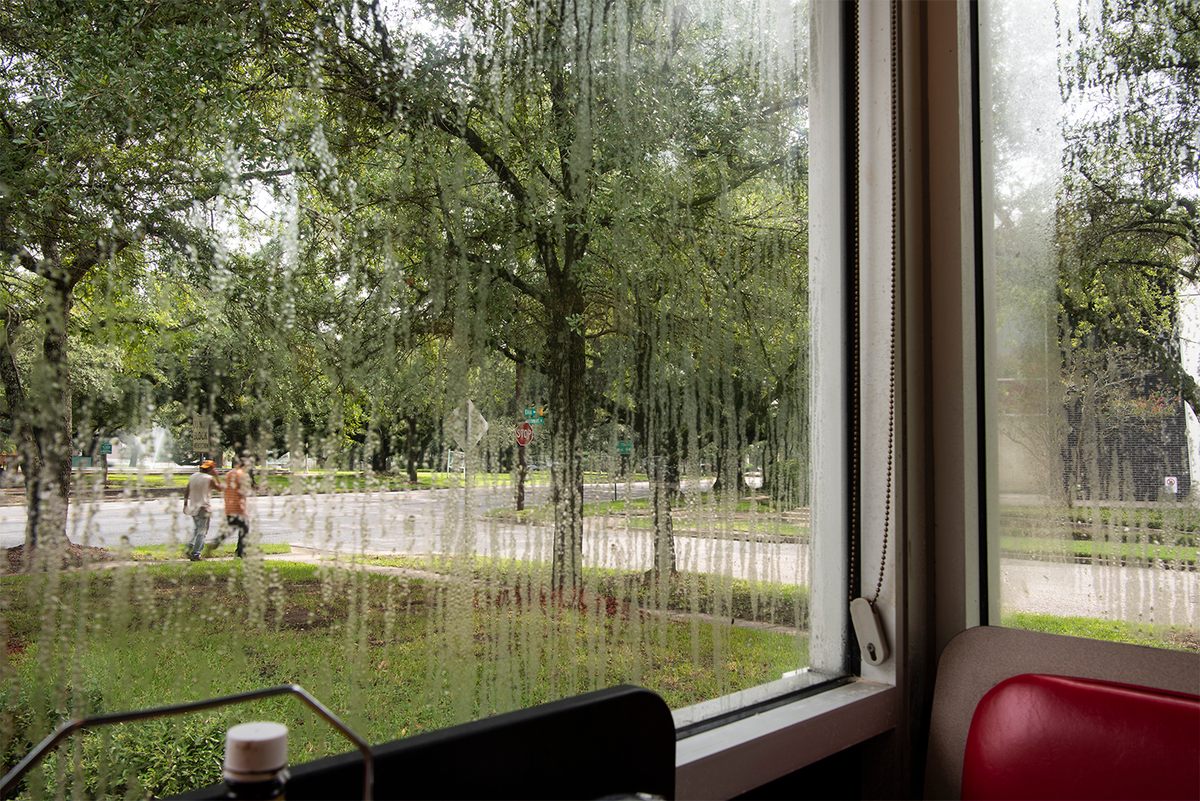
In a photo of Store #1655 in Monroe, North Carolina, a predominantly white county with a median per capita income of $23,732, signs for Good Steward Ministries Thrift Store and Knife Fork Family Restaurant tower over a half-filled parking lot. In a photo of store #1912 in Mobile, Alabama, a predominantly Black city with a median income of $27,000, condensation obscures an image of two men walking under the tree canopies of a lush suburban street.
The foregrounds of each image, which often contain red leather seats, napkin dispensers, and condiment bottles, remind the viewer that they are sitting in a Waffle House rich with the smells of waffle batter and sweet syrup. “That allowed every viewer to bring their lived experience into the photograph without me having to prompt it,” Cash says.
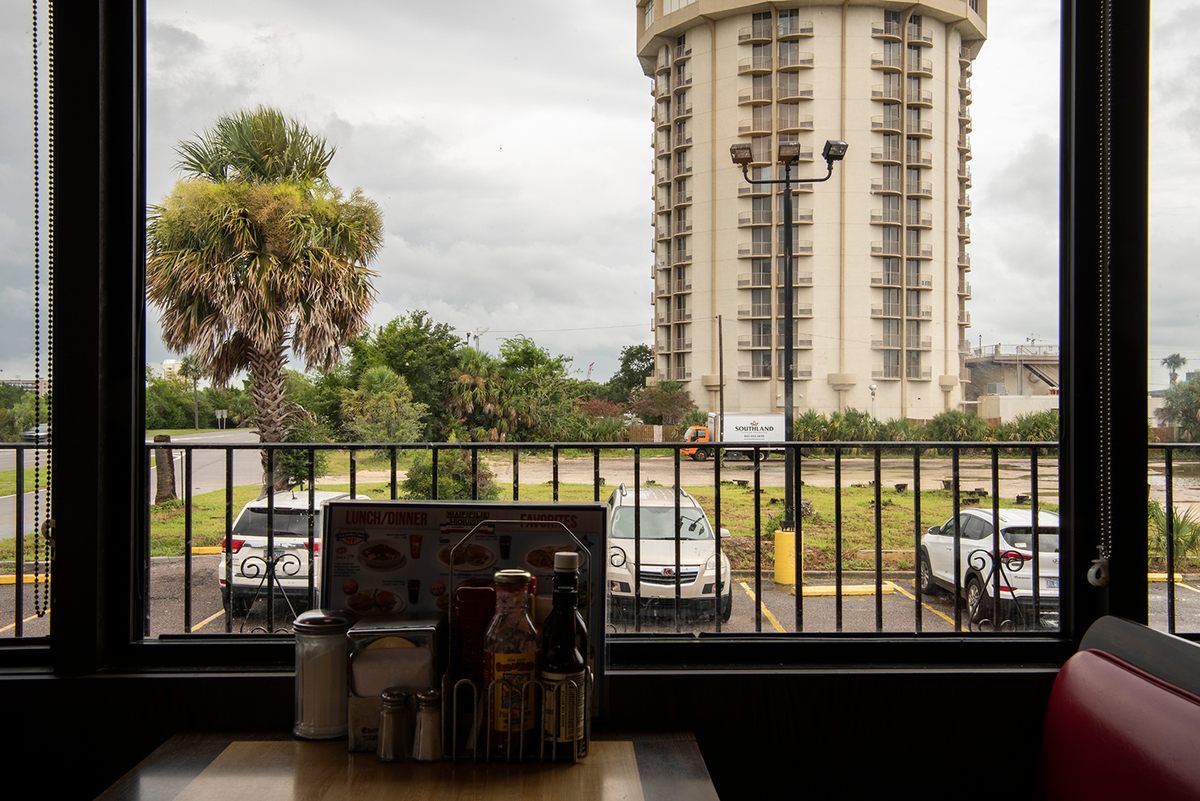
For many people, these experiences are of a place where time slows down and connections open between friends and strangers. Waffle House Vistas seems to have had a similar effect on readers. Cash and his publisher have received so many positive reactions to the book from Waffle House loyalists that they plan to publish an expanded version this winter. Some readers have told Cash that they recognized the exact booth from a photo. “They would say, ‘Oh, my god. This was a booth that I sat in, looked out the window, and tried to figure out how to be me, how to live my life,’” he recalls.
Behind the camera, the Waffle Houses in the pictures were alive with chatter. As Cash snapped photos, he heard “the sound of plates clanking together,” and “the sizzle of fried bacon, hash browns, and fried eggs” on the griddle. “The other sounds that you hear consistently, even if I’m in there by myself,” he adds, “is people talking, whether it is other patrons or the staff just conversing with each other, usually having a good time.”
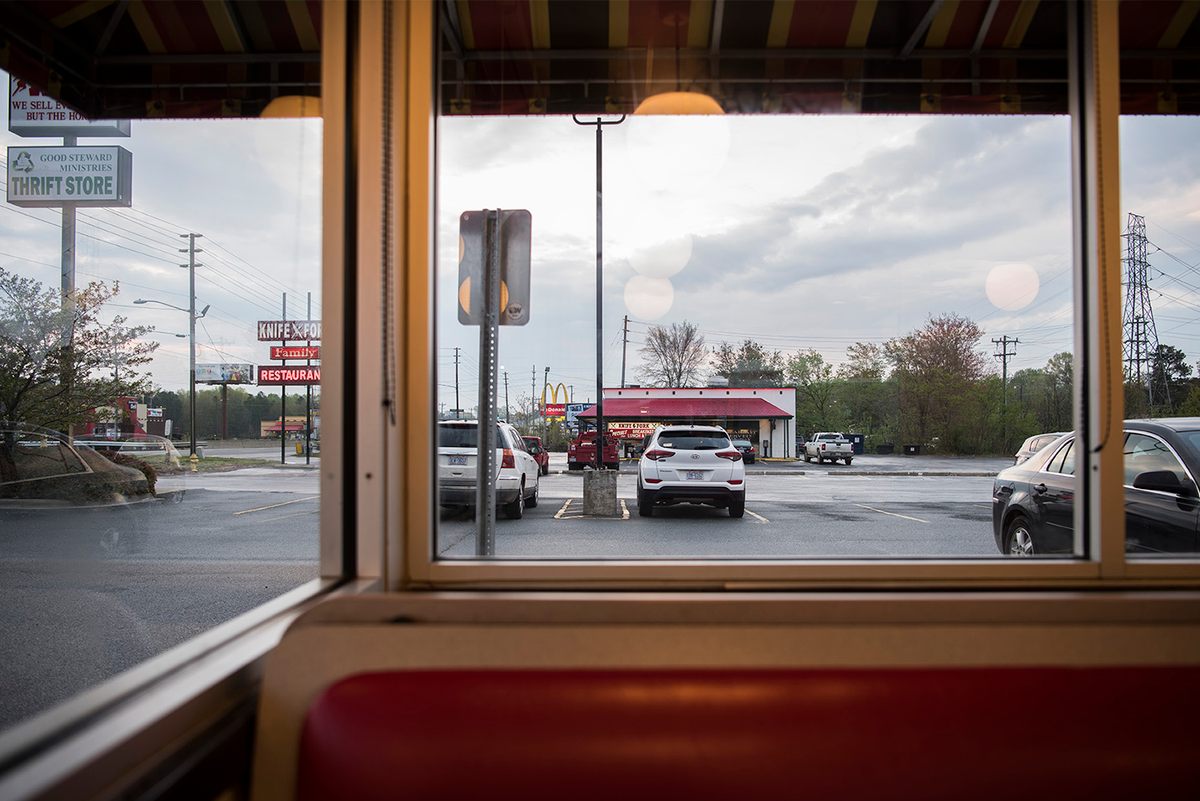
In the book’s foreword, Maurice Carlos Ruffin recalls a particularly memorable meal at a Waffle House in Alabama: “My friend was Jewish, and we laughed that a Black man and a Jewish woman walking into a diner in the Deep South sounded like a great set-up for a funny joke. But there was no joke. We went. We were greeted, seated, and served. I had a crispy waffle swimming in syrup with a side of ham. I left with a full belly and a smile on my face just like anybody. That’s the experience I’ve had every time I’ve gone to a Waffle House.”
Cash says that during his tour of the Southeast’s Waffle Houses, he drank coffee alongside people from various backgrounds, races, and socioeconomic classes, a microcosm of the communities in which the restaurants were located. Sometimes, he’d hear three or four different languages in a single morning. His fellow diners arrived at Waffle Houses on buses, in old cars, and in Teslas and Mercedes.
For Cash’s family, as with many others, eating at Waffle House has become a tradition. He remembers visiting Waffle House with his brother and father on road trips, where they would sit down to a big breakfast and watch in wonder as the cooks fried hash browns and eggs in the open kitchen. More recently, he took his son, normally a picky eater, there for his first chocolate waffle. “The look on his face when he realized that chocolate and syrup taste good together was one of pure delight and discovery,” he writes.

Still, Waffle House is far from perfect. Racist incidents are periodically reported at Waffle Houses, perpetrated by customers, police officers, and staff. As Laura Bullard writes in the book’s conclusion, “The Southern diner as backdrop to racial violence is as old as the Southern diner itself.” Cash believes that when these incidents happen at a Waffle House, they receive extra media attention because most people view Waffle House as a haven. It’s been the site of bravery, as well. In 2018, when a gunman opened fire at a Waffle House in Antioch, Tennessee, killing four people, customer James Shaw disarmed him before he could cause any more harm and was hailed as a hero.
Cash has meditated on why so many people often find sanctuary at Waffle House. “There is nothing spectacular about it,” he says of the food. But it is reliable. “If you are really hungry on a road trip, you didn’t eat a lot the night before—if you’re really hungover, for instance—it’s going to come to you the way you expect it to, and it’s going to be delicious.” One can imagine the curative power of a 2 Egg Breakfast with sausage and grits for a cold, weary traveler at Store #1449 in Calvert City, Kentucky, where Cash photographed a yellow 18-wheeler crossing a highway overpass hedged by leafless trees.
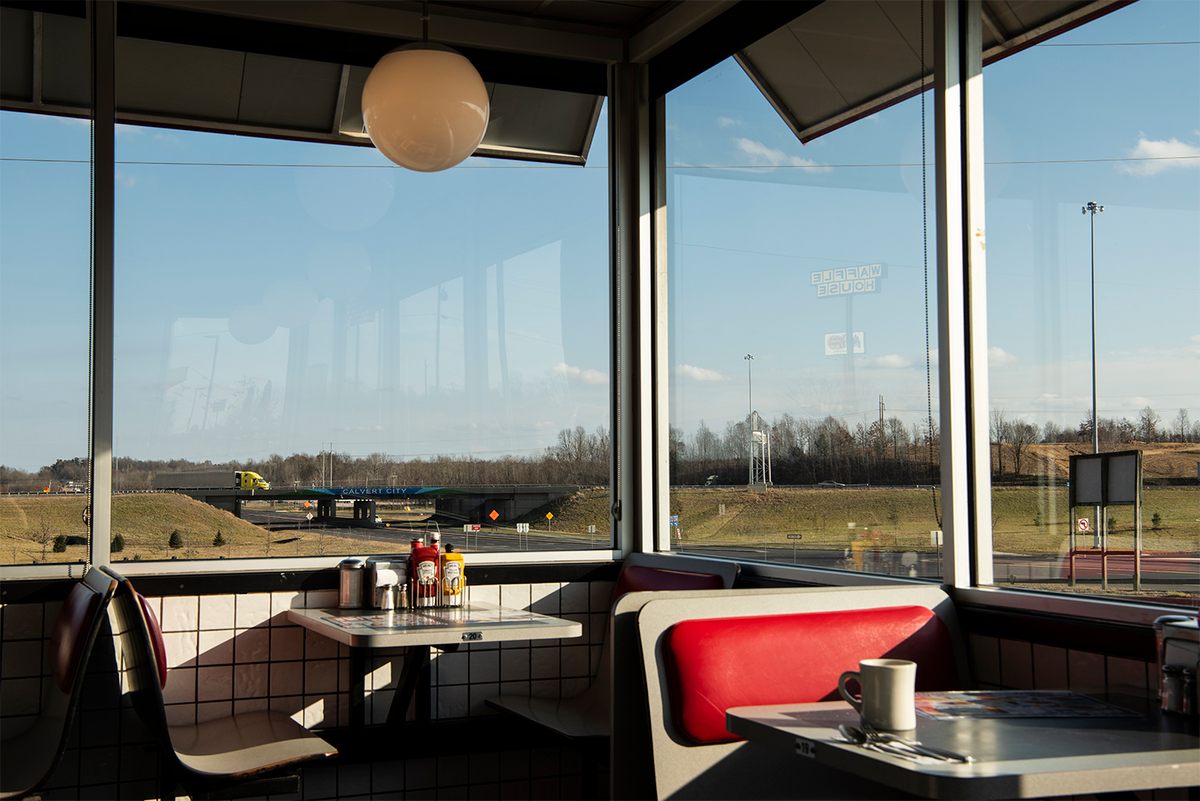
Or maybe it’s just the congeniality. An Eater article mused that the chain might command such steadfast loyalty because of “the waitresses that inevitably call you ‘honey.’” The result, Cash says, is a place where people “can be who they are,” where even people picking up mobile orders linger to chat.
And it doesn’t hurt that they serve breakfast food: “Breakfast food is like fireworks. Everybody likes it,” he says. “No matter what the holiday, if there’s a firework show, everybody is going to stop their car, come on out to the field and watch some fireworks, get along for 20 minutes, and then go on with their lives.”
He sees profundity in the deliciousness of such prosaic food as scrambled eggs and toast. “Doesn’t that sort of parallel or mimic our existence? Treat people well and you’re going to have a better life. Like the golden rule. It’s simple.”
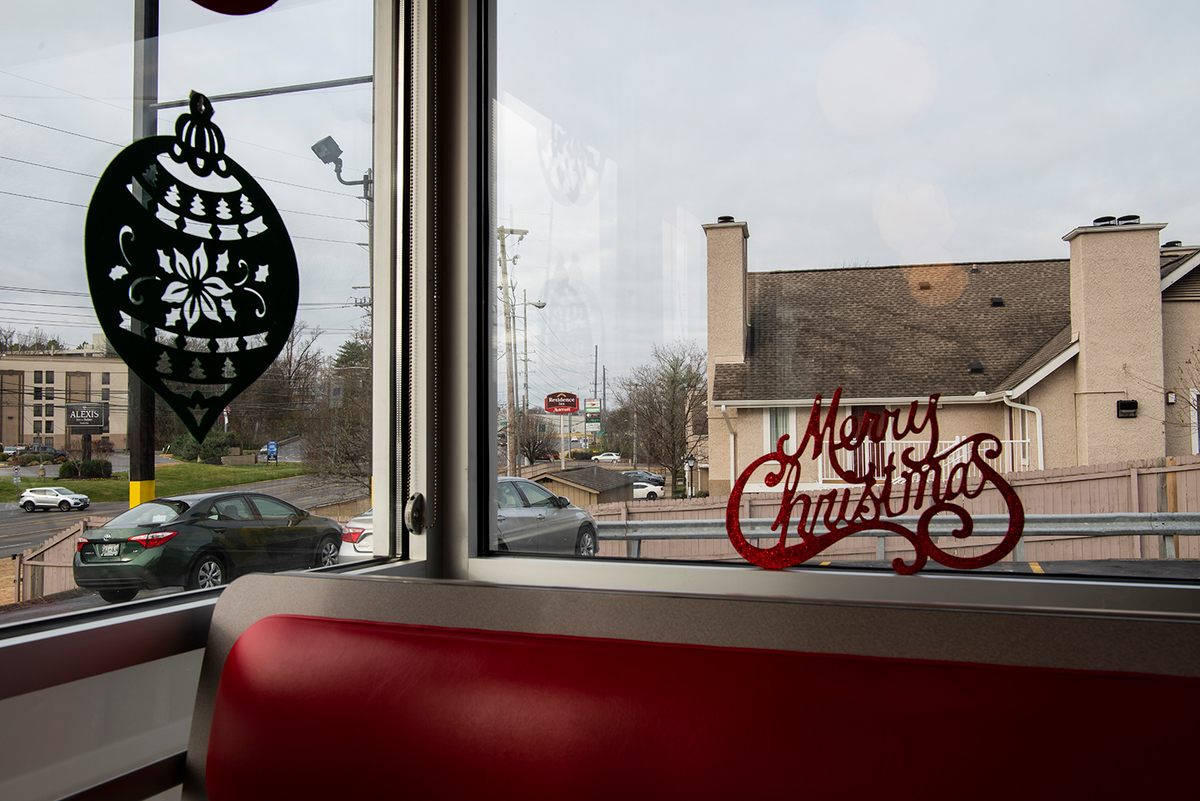
Gastro Obscura covers the world’s most wondrous food and drink.
Sign up for our regular newsletter.



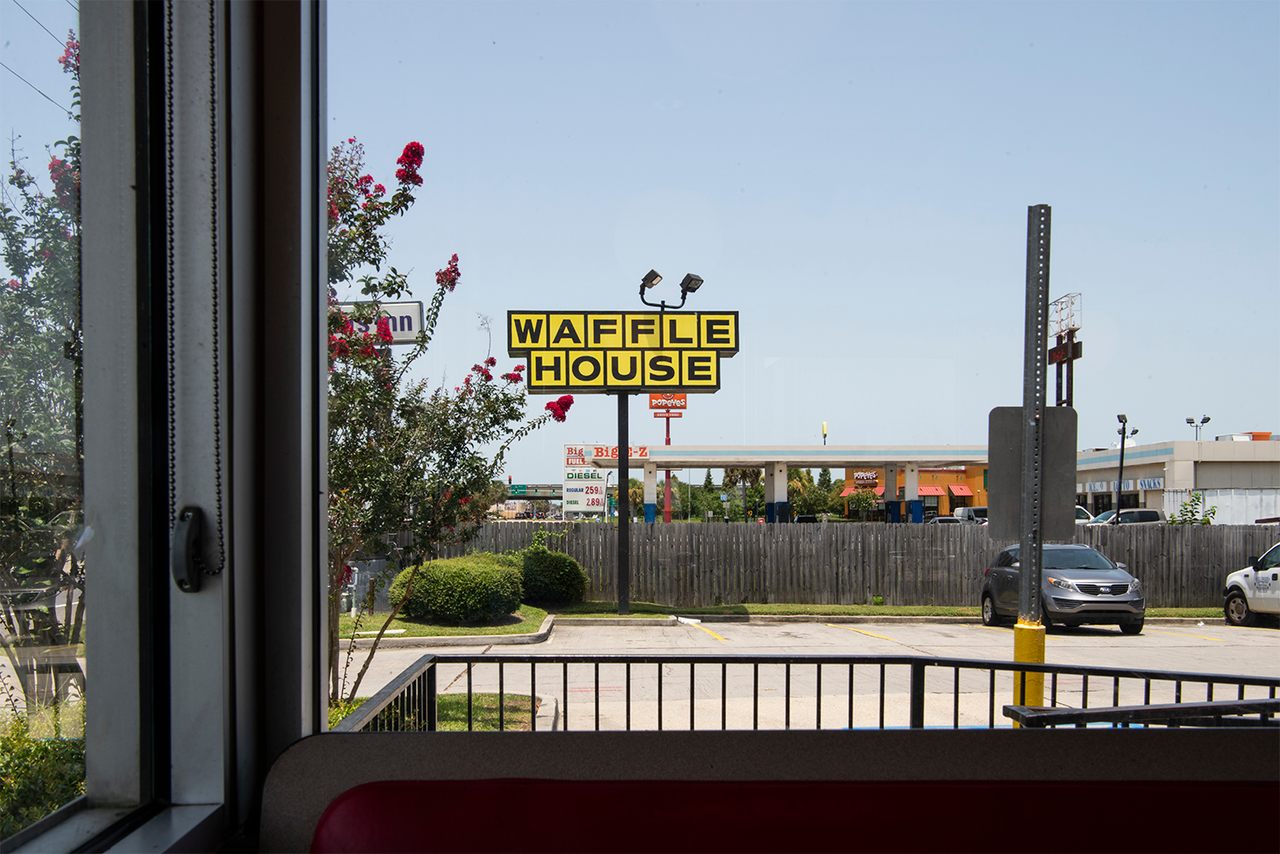

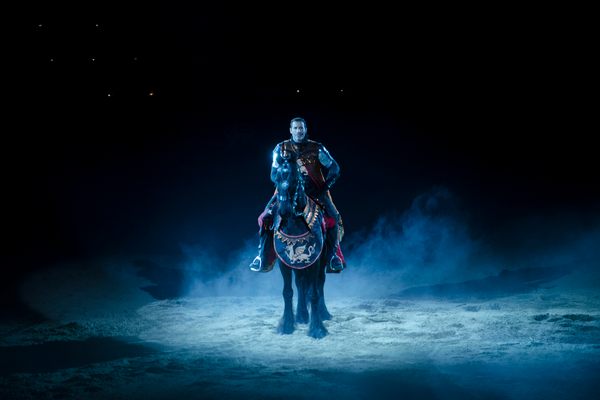


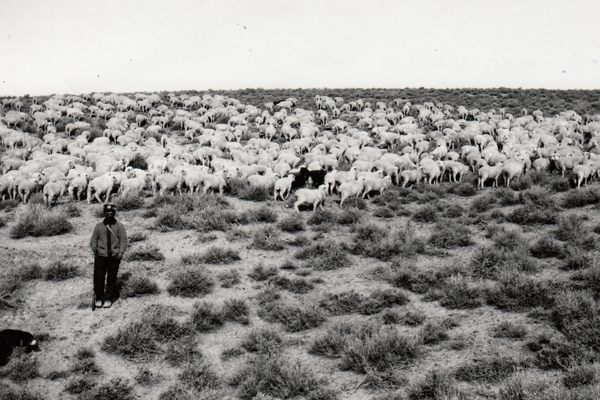
































Follow us on Twitter to get the latest on the world's hidden wonders.
Like us on Facebook to get the latest on the world's hidden wonders.
Follow us on Twitter Like us on Facebook